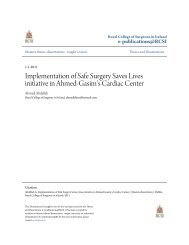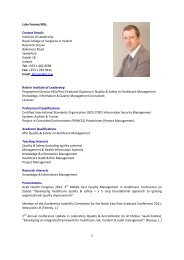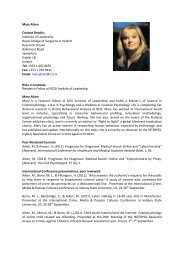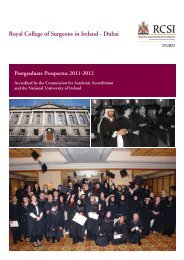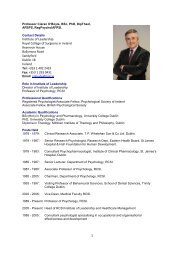Improving the Assessment and Triage of Patients with Mental Illness ...
Improving the Assessment and Triage of Patients with Mental Illness ...
Improving the Assessment and Triage of Patients with Mental Illness ...
Create successful ePaper yourself
Turn your PDF publications into a flip-book with our unique Google optimized e-Paper software.
Chapter 1<br />
Introduction<br />
1.1 Introduction.<br />
Change involves altering <strong>the</strong> way things are done <strong>with</strong> <strong>the</strong> intention <strong>of</strong> improving<br />
practices. This is particularly relevant to <strong>the</strong> Health Services which is in a constant <strong>of</strong><br />
transformation <strong>and</strong> reform. The Emergency Department (ED) is a prime example <strong>of</strong> this.<br />
There is a continuous endeavour to improve <strong>the</strong> delivery <strong>of</strong> care <strong>and</strong> services to <strong>the</strong> public.<br />
This process involves assessment, planning, implementation <strong>and</strong> evaluation to achieve <strong>the</strong><br />
quality <strong>of</strong> service required (Welford, 2006). All changes must have <strong>the</strong> patient as <strong>the</strong> central<br />
focus <strong>of</strong> any initiative, <strong>and</strong> accordingly, in <strong>the</strong> context <strong>of</strong> this project, patient welfare was a<br />
primary consideration in my decision to implement a change in <strong>the</strong> way ED staff triage those<br />
who present for treatment. This project was undertaken in a busy ED in Dublin. The change<br />
process was carried out in conjunction <strong>with</strong> <strong>the</strong> Health Service Executive (2008) Change<br />
Model.<br />
In this chapter I discuss <strong>the</strong> rationale for choosing this particular change management<br />
project which addresses <strong>the</strong> triage <strong>and</strong> assessment <strong>of</strong> patients <strong>with</strong> <strong>Mental</strong> <strong>Illness</strong> in <strong>the</strong> ED.<br />
The presentation <strong>of</strong> this group <strong>of</strong> patients attracts extensive debate <strong>with</strong>in <strong>the</strong> department <strong>and</strong><br />
<strong>the</strong>refore I believed that I should devote my time to bringing about change to improve <strong>the</strong><br />
assessment <strong>and</strong> treatment <strong>of</strong> <strong>the</strong>se patients. Chapter 2 relates to <strong>the</strong> Literature Review where I<br />
consider mental illness <strong>and</strong> its prevalence in today’s society <strong>and</strong> <strong>the</strong> negative attitudes<br />
towards mental illness. In <strong>the</strong> final section <strong>of</strong> <strong>the</strong> Literature Review I discuss <strong>the</strong> concept <strong>of</strong><br />
triage <strong>and</strong> its importance in <strong>the</strong> ED. I also examine <strong>the</strong> <strong>Mental</strong> Health <strong>Triage</strong> Tool devised in<br />
Australia for use in <strong>the</strong> assessment <strong>of</strong> patients <strong>with</strong> <strong>Mental</strong> <strong>Illness</strong>.<br />
Chapter 3 deals <strong>with</strong> Methods which involves a discussion <strong>of</strong> organisational culture<br />
<strong>and</strong> considers its significance in <strong>the</strong> change process. A brief analysis <strong>of</strong> <strong>the</strong> chosen change<br />
model (<strong>the</strong> Health Service Executive (2008) Change Model) <strong>and</strong> <strong>the</strong> rationale for its selection<br />
1





